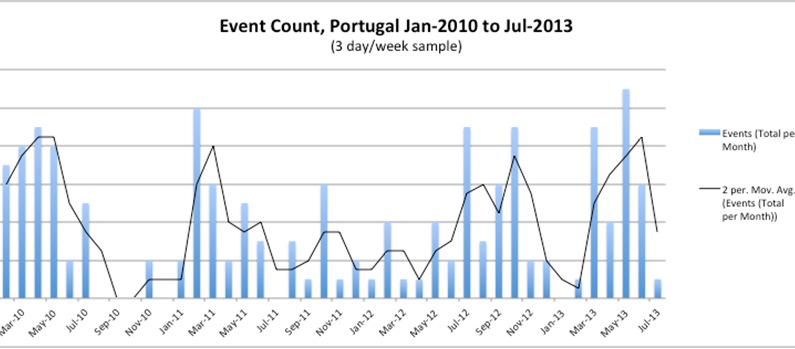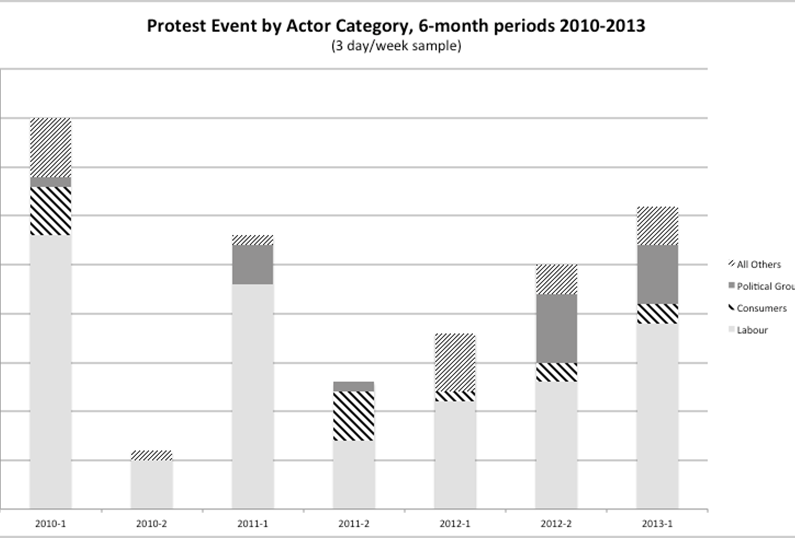Patterns of protest in Portugal show the relationship between the ‘old’ politics of labour and ‘new’ anti-austerity movements
The financial crisis of 2007-08, and the subsequent Eurozone crisis ushered in a Europe-wide era of lowered public spending. This, in turn, created a wave of protests about the iniquities of spending cuts, unemployment, and public services reduction. Guya Accornero and Pedro Ramos Pinto look at protests in Portugal – one of the worst affected countries – and show a complicated relationship between traditional political actors such as unions, and new social and protest movements.

Ponte de Don Luis, 1 (Credit: Jan Role, CC BY NC SA 2.0)
According to the European Social Survey’s data for 2012, the percentage of people who reported participating in at least one demonstration grew significantly between 2008 and 2012. This phenomenon is clearly connected to the onset of the economic crisis and with the austerity measures voluntarily adopted by several governments or imposed on them by international institutions.
A recurring feature of these mobilisations in the areas of Europe most affected by the fallout of the economic crisis (notably in Southern Europe) has been the emergence of forms of contention outside the traditional political framework which carry a radical critique of existing political institutions. These have led some authors to talk of the birth of ‘new new’ social movements and the decline of traditional political organisations, such as formal parties or trade unions.
The analysis we realized of one of the countries most affected by the Eurozone crisis, Portugal, put in part in discussion this assumption. It suggests that the ‘old’ politics of trade unions and the support they can mobilise continue to be central to the field of protest. Our study also shows that, in Portugal at least, both unions and anti-austerity movements have gradually entered into tentative alliances. Unions seek in the new movements access to a broader constituency and a language that resonates more widely than the diminishing number of traditional union members; anti-austerity movements seek in the unions the organisational capacity that would allow them to apply sustained pressure on their targets.
Austerity and Protest in Portugal
Portuguese citizens have suffered in the last few years from the imposition of drastic cuts in public spending upon which the international financial assistance of the so-called Troika (IMF, ECB and EU) was dependent. In March 2011, having failed pass a package of austerity measures in parliament, the Socialist government headed by José Socrates resigned. This paved the road to external intervention, which arrived in the form of €78b from the ‘Troika’, with tight conditionality in terms of containment of budget deficits and structural reforms, which would be enacted by a new government, elected in June 2011 and headed by the centre-right Partido Social Democrático (PSD). It was from that moment on that the harshest austerity measures were applied, including large cuts in public sector salaries, pensions, benefits and services. Along with tax rises (mainly in VAT), these measures produced a drastic decline in levels of consumption and employment, creating a vicious recessionary cycle.
Portugal had long been one of Western Europe’s most unequal countries, but gains in that respect (the GINI index of income inequality had been decreasing since the early 2000s, are being reversed as a consequence of the crisis. According to Eurostat, the average salary measured by purchase capability in 2012 is 25% below the European average, evidencing a drastic reduction starting in 2010. Unemployment increased from 7.6% in 2008 to 13.9% in 2014, reaching 34.8% in the case of under-25-year-olds. Not surprisingly, rapid increases in the incidence of material deprivation have been registered, from 20,9% in 2010 to 25,7% in 2014. Driven by these conditions, emigration levels have started growing again, reaching rates not seen since the 1960s and 1970s.
Portugal resorted to IMF loans twice before, in 1978 and again in 1983. At the time, the country reacted with large protests – especially associated with the working class – as conditionality-driven austerity took its tool. A similar response can be seen today. Following the European Social Survey in 2013, the proportion of respondents stating participation in a public demonstration in the previous year more than doubled, from 2.4% in 2010 to 6.8%. A study developed by Portuguese police confirmed these data. It shows that, only in Lisbon, demonstrations increased from 244 in 2010, to 298 in 2011 and to 579 (one every 15 hours) in 2012.
Our analysis of this political cycle also points in this direction. We created a database from a sample of protest events reported in the Portuguese media between 2010 and 2015. This data shows the evolution of a protest cycle starting in 2010, coinciding with the arrival of the first austerity measures in Portugal. These measures were opposed by several public protests, most significantly by a general strike on 4th March 2010, followed by various demonstrations organized by the trade union federation CGTP (General Confederation of the Portuguese Workers) in early July. A further general strike was held in November and from that moment on social protest grew significantly. The peak of this early agitation was a mass demonstration on 12th March 2011. This demonstration was mainly novel in that it was called via social media by a small group of activists unconnected to traditional parties or unions. Calling itself the Geração à Rasca (‘Desperate Generation’), it shared some aspects with the Spanish Indignados movement, although it appeared earlier than its neighbouring counterpart. With an emphasis on the rejection of existing political institutions, on direct forms of democracy, and the use of social media as a mobilizing tool, this could be characterized as part of what some authors have called ‘new new social movements’.
The March 2011 demonstration contributed to the final delegitimation of the socialist government, who would resign soon after. It also marked the start of a period of reconstitution of the Portuguese contentious arena. The organizers of the Geração à Rasca protest created the M12M (Movimento 12 de Março -12th March Movement) platform, which refused to be defined in a left-right axis, while adhering to José Saramago’s appeal of ‘turning every citizen into a politician’. After the 2011 elections, two more peaks of protest activity appear clearly: in the latter half of 2012, and between March and June 2013. These included some of the largest demonstrations in Portuguese history, on 15 September 2012 and 2 March 2013, both organized by a new movement evolved from the ‘Despearate Generation’ protests: the Que se Lixe a Troika (‘The hell with the Troika: we Want our Lives Back!’ – the QSLT). Just like the M12M, and being a partial evolution of it, the QSLT defined itself as apolitical in its slogans, announcements and propaganda. Meanwhile, its left-wing position is clear, if not for the important presence of BE militants, of organizations such as the Precários Inflexíveis (Inflexible Precarious) e by the occasional alliance with the CGTP.
Outwardly, it would seem that Portuguese protest cycle was being driven primarily by these organisations. Our analysis reveals, however, that this cycle of protest should not be understood as solely the product of new kinds of social movements. Instead it must be put in the context of a broader upsurge in protest that is, for the most part, underpinned by the mobilizing capacity of an ‘old’ style of politics – labour unions.
From 2012 a strategy of closer collaboration between the different contentious actors, olds and news, can be detected. The QSLT movement and the communist-allied trade union CGTP supported each other’s’ demonstrations between September 2012 and March 2013. Equally, the ‘new movements’ increasingly made use of references to symbols of protest and democracy drawn from the revolutionary period of 1974-1975. One example is the use of the iconic revolutionary song ‘Grândola, Vila Morena’ as the anthem of the great QLT demonstration (800,000 strong according to some) on 2nd March 2013.
The Portuguese anti-austerity protest cycle seemed to stop in June 2013, apparently without leaving significant modifications on the political landscape. In the 2014 European elections, the usual constellation of Portuguese parties did not show any particular change: the Socialist and the Social-Democratic Parties continue to win most votes, followed, as usual, by the Communist-Green coalition. The only innovation has been the appearance of a new party – LIVRE -, which, gathering together different left-wing forces, aims to represent the discontent with the economic and social situation. Not rooted in the previous season of social mobilization, this party did not achieve a ‘spectacular’ result in the European elections, obtaining only the 2,18% of votes. For both these reasons, this organization is not comparable to the Spanish Podemos, nor to the Greek Syriza. But the ‘game’ for the next Portuguese political elections (September-October 2015) is still open and there is still time for some surprises upsetting the Portuguese political landscape.
—
This post represents the views of the author and not those of Democratic Audit or the LSE. Please read our comments policy before posting.
—
 Guya Accornero, Instituto Universitário de Lisboa
Guya Accornero, Instituto Universitário de Lisboa
 Pedro Ramos Pinto, University of Cambridge
Pedro Ramos Pinto, University of Cambridge







 Democratic Audit's core funding is provided by the Joseph Rowntree Charitable Trust. Additional funding is provided by the London School of Economics.
Democratic Audit's core funding is provided by the Joseph Rowntree Charitable Trust. Additional funding is provided by the London School of Economics.
https://t.co/vd8KbnMkam
Patterns of protest in Portugal show the link between the ‘old’ politics of labour and ‘new’ anti-austerity movements https://t.co/tZ87Zgs67M
Patterns of protest in Portugal show the links between the old politics of labour and new anti-austerity movements https://t.co/Dq7uPgIlEK
Protest in Portugal show the relationship between the ‘old’ politics of labour and ‘new’ anti-austerity movements: https://t.co/rH6Dfegnxz
Patterns of protest in Portugal show how the ‘old’ politics of labour relates to ‘new’ anti-austerity movements https://t.co/mPbnF7BW4j
Patterns of protest in Portugal show the relationship between the ‘old’ politics of labour and ‘new’ anti-austerit… https://t.co/yUcfz2pWNt
Patterns of protest in Portugal show the relationship between the ‘old’ politics of labour and ‘new’ anti-aust… https://t.co/Joe9T8sdmk
Patterns of protest in Portugal show the relationship between the ‘old … https://t.co/kCmkSyd6X1 #Protest
Patterns of protest in Portugal show the relationship between the ‘old’ politics of labour… https://t.co/wfXX1uHGXx https://t.co/FtJxibcVlB